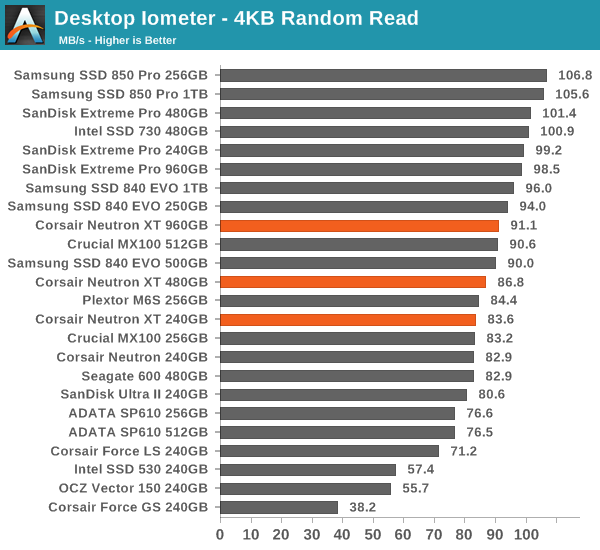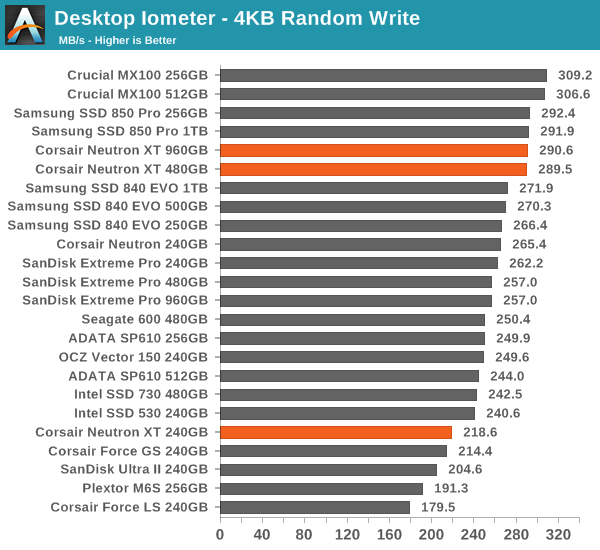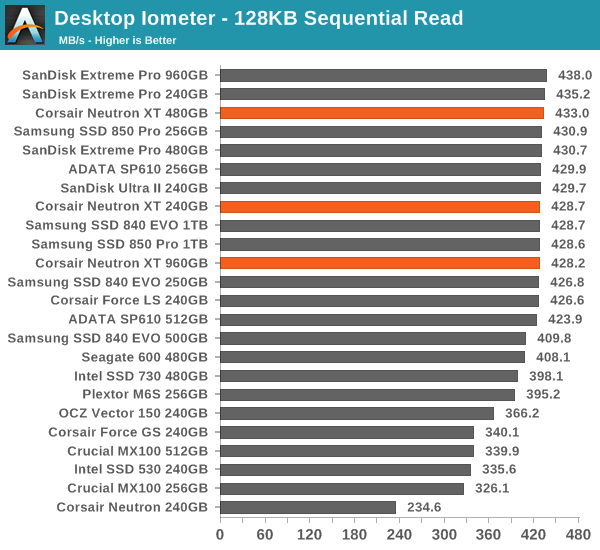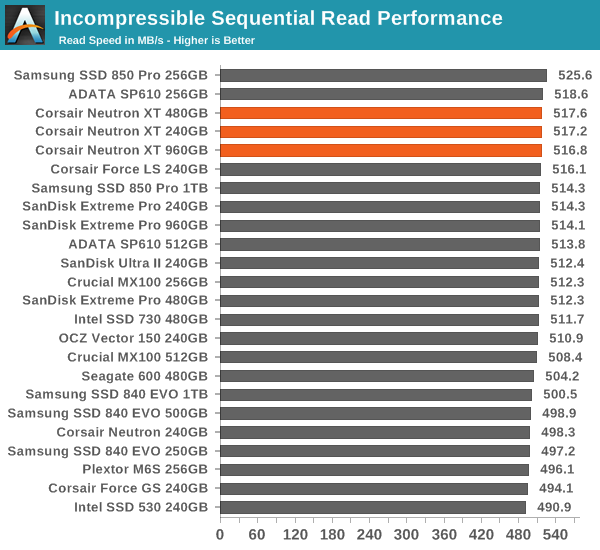Corsair Neutron XT (240GB, 480GB & 960GB) SSD Review: Phison S10 Debuts
by Kristian Vättö on November 17, 2014 9:00 AM ESTRandom Read/Write Speed
The four corners of SSD performance are as follows: random read, random write, sequential read and sequential write speed. Random accesses are generally small in size, while sequential accesses tend to be larger and thus we have the four Iometer tests we use in all of our reviews.
Our first test writes 4KB in a completely random pattern over an 8GB space of the drive to simulate the sort of random access that you'd see on an OS drive (even this is more stressful than a normal desktop user would see). We perform three concurrent IOs and run the test for 3 minutes. The results reported are in average MB/s over the entire time.

Random read speed gets a boost compared to the Force LS and the Phison finally appears to be on-par with the others.


Random write speed is also good, although the 240GB model could perform better at lower queue depths.
Sequential Read/Write Speed
To measure sequential performance we run a 1 minute long 128KB sequential test over the entire span of the drive at a queue depth of 1. The results reported are in average MB/s over the entire test length.

Here we see the performance drop when the capacity increases again. The 960GB model is quite noticeably slower in write speed compared to the rest of the capacities, although at 355MB/s it definitely isn't slow.

AS-SSD Incompressible Sequential Read/Write Performance
The AS-SSD sequential benchmark uses incompressible data for all of its transfers. The result is a pretty big reduction in sequential write speed on SandForce based controllers, but most other controllers are unaffected.












56 Comments
View All Comments
hojnikb - Monday, November 17, 2014 - link
Because they are using samsung's controllers. And they already have pci-e controllers.close - Monday, November 17, 2014 - link
Because Apple only has to worry about their own product, and their PCIe SSDs come attached to a device capable of using it. So you don't buy a PCIe SSD, you buy an Apple device that comes with a PCIe SSD inside. Other integrators/OEMs don't care to do it as it increases costs so it's suitable only for high end. For now. Apple is doing it because it would seem that their customers can afford to pay the premium regardless of other aspects.Kristian Vättö - Monday, November 17, 2014 - link
There has been a handful of PCs with the XP941, but you are right that Apple is mostly the only one.The PC OEMs tend to cut in cost wherever possible because their margins are already razor thin. The XP941 is more expensive than SATA drives because it's the only PCIe x4 drive on the market and in addition the PC OEMs can use the same SATA drives in various models, whereas the XP941 would only fit in high-end models due to the cost.
For Apple this isn't an issue because the quantities they buy the XP941 in are so large and Apple also has a significant share of the high-end market, which is where the PC OEMs struggle. Plus Apple is one of the only companies that fully understand that it's the user experience that counts.
alaricljs - Monday, November 17, 2014 - link
> Plus Apple is one of the only companies that fully understand that it's the user experience that counts.Have to point out here that Apple is one of the only companies where the hardware is just another piece of the user experience puzzle that they have control over. Whereas for PC manufacturers it's almost the only part of the user experience they have control over.
Mikemk - Monday, November 17, 2014 - link
Apple needs to realize that again.warrenk81 - Tuesday, November 18, 2014 - link
thanks! i've been wondering about this since the MacBook Airs started with the PCIe SSDs in 2013.Shiitaki - Wednesday, November 19, 2014 - link
Apple produces the entire machine, so they don't have to worry about what the rest of the industry is or isn't doing. Because Apple can put the necessary driver support in their motherboard firmware to boot from a PCI-E drive. Apple also produces the operating system, so they can use a custom driver and not wait for 'official support'.Flunk - Monday, November 17, 2014 - link
Oh god I hope not, SATA Express' cable standards are a huge mess I hope we never need to deal with. Why we need yet another standard where M.2 makes massively more sense I can't imagine.SleepyFE - Monday, November 17, 2014 - link
Because of the cable. When you have a tower case you can fit 5+ drives in it and connect via cable. The M.2 is just for laptops as it has to be fixed at the end with a screw an therefor has to lay on something. To put it on an ATX motherboard would take up too much space or it would dangerously dangle from the board. You could use a M.2 to PCI-e connector, but why waste the PCI-e slot? And what's the point of M.2 if you're just gonna plug it into PCI-e anyway? For big cases you need cables. They might be a mess, but you can use the SATA-X (-X= Express) for the boot drive and put all your old drives into SATA ports, so you don't waste them.MrSpadge - Monday, November 17, 2014 - link
It's a bit surprising that it takes so long - not because it would be easy, but because we've known since a long time this would be coming. The manufacturers should have known it long before us. And it's not like there has been any other significnat movement regarding SSD controllers in the past 2 years.On the other hand - I don't mind if they take their time and deliver polished products with firmware which is not in beta state any more!